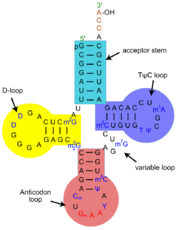Structure

Standard 2D cloverleaf structure of tRNA. The shown example is phenylalanine-specific tRNA from yeast
tRNA is a stable, folded type of RNA present in all living cells. The secondary structure of most tRNA
[3][4] is composed of four helical stems (shown in cyan, blue, red and yellow) arranged in a cloverleaf structure and an central four-way junction. , tRNA adopts an "L" shape, with the acceptor end on one end and the anticodon on the other end.
At the acceptor end, amino acid are attached via the . At the opposite end of the molecule is the , which pairs with its complementary codon on the messenger RNA.
The two arms of the "L" are formed by the on one side, and of the anticodon and D-stem on the other side. form the corner of the L-shape and stabilize the structure. Non-Watson-Crick hydrogen bonding is important in this core (visualize interactively at DSSR Jmol web interface)).
In addition to the four stem loops, tRNA have a variable loop located in between the acceptor and D-stems. This variable loop can be quite small, but for some tRNA such as the serine or leucine-specific tRNA, it can form an additional helix.
Modified nucleotides. Most tRNAs contain modified nucleotides[5], which are added post-transcriptionally by specific enzymes. Common modifications include isomerisation of uridines into pseudouridines (Ψ), methylation of either the ribose and/or the base, thiolation, reduction of uridines into dihydrouridines (D).
The anticodon loop of the tRNA quite often contains hypermodified bases, the function of which is to stabilize the codon-anticodon interaction within the ribosome. The nature and position of nucleotide modifications is both specific of the organism and the tRNA type. Common modified nucleotides include:
- 5-methyluridine (ribothymidine) at position 54
- (note the carbon-carbon bond connecting sugar and base)
- dihydrouridine(s) in the D-loop
- 7-methylguanosine at position 46
See also Transfer RNA tour.
Function
Cells usually have sets of tRNAs corresponding to all 20 standard amino acids, with anticodons capable of pairing with the 61 "sense" or coding codons. Within the cell, each tRNA undergoes an aminoacylation-deacylation cycle. tRNA are attached to their cognate amino acid ('charged with' or 'aminoacylated') by a family of enzymes called Aminoacyl tRNA Synthetases. Charged tRNA associate with the elongation factor EF-Tu (bacteria) or EF1 (eukaryotes) complexed to GTP. These ternary complexes bind to the ribosome. If codon and anticodon are complementary, translation can proceed, the amino acid is incorporated at the C-terminal end of the polypetide chain and eventually, the deacylated tRNA is release for another aminoacylation-deacylation cycle.
Interaction with ribosomes and mRNA. Ribosomes have multiple . During protein synthesis, the partially synthesized protein is always covalently attached to a tRNA bound to the ribosome. When a new tRNA charged with a single amino acid binds to the ribosome, the partially synthesized (nascent) protein is transferred onto the new amino acid bound to the incoming tRNA (the ester bond between nascent protein and tRNA is broken and a new peptide bond between nascent protein and the new amino acid is formed), elongating the nascent protein by one amino acid. This chemistry happens at the 3’-OH of the acceptor stem of tRNA. The other end of tRNA has a role in selecting the correct tRNA (charged with the correct amino acid) through interactions between the anticodon loop at the other end of tRNA with codons on the messenger RNA bound to the ribosome and presented to the tRNA.
There are special mechanisms to get protein synthesis started (initiation), and to end it (termination). Initiator tRNA is a Met-tRNA which recognizes the methionine codon which is the initial codon in protein synthesis. Initiator-tRNA differs from the protein elongation Met-tRNA by forming a complex with IF-2 and GTP, by bonding to the ribosomal P-site and exclusion from bonding to the ribosomal A-site.
Aminoacylation. Aminoacyl tRNA Synthetases pair amino acids with tRNAs. In this way, they implement the genetic code. These enzymes recognize a single tRNA (e.g. phe-tRNA) and a single amino acid (phenylalanine, in this example) and catalyze formation of an ester bond between the 3’-hydroxyl of the tRNA and the carboxylatic acid of the amino acid.
. The cognate aminoacid is esterified on its 3'-OH by the cognate aminoacyl-tRNA synthetase. The synthetase recognizes structural features on the tRNA, which allows it to discriminate tRNA that are specific for a given aminoacid, from all other (non-cognate) tRNA. These structural features are called identity determinants. They are often (but not exclusively) located in the anticodon sequence and/or in the so-called discriminator base (position 73), just before the 3' -CCA terminus.



